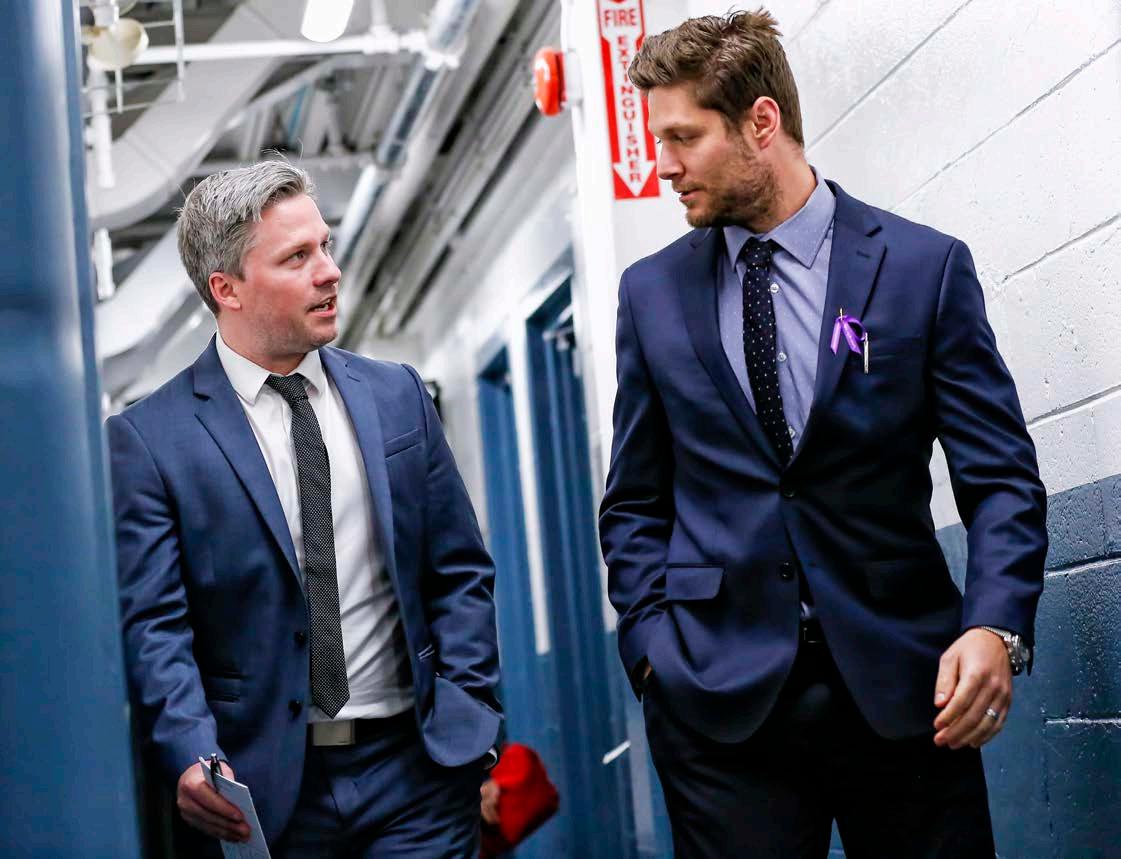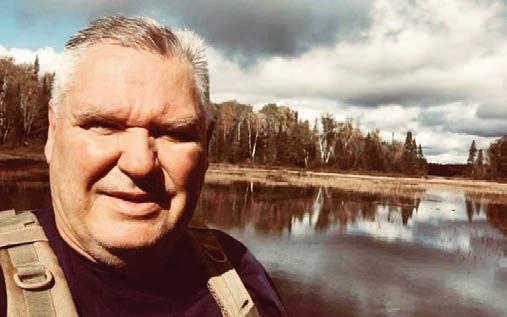
8 minute read
Hockey Development During A Pandemic
HOCKEY DEVELOPMENT
DURING A PANDEMIC
Advertisement
A Parent’s Guide to Dealing with the concerns of skill development during these times of uncertainty.
By Total Sports Staff
Overview • Make the training fun. The player needs to want to do This is a culmination and collaboration of thoughts and advice Perfetti, “He is a hockey nut. He wants to be on the ice all of provided by our expert panel via a three part series on the Total the time., He has that desire to get better.” The player has Sports Quinte Podcast hosted by Randy Uens and Mike Bonn. to have fun to get better. The Podcast can be found through ITunes, Spotify, IHeartRadio or even modified games it is only a small blip in the players types of development. Seek out other opportunities for skill development. • Do your homework with skill providers. Who are they?
What’s their background? Who have they worked with that has gone on to be successful? Ask for references. There are skill providers out there with professional hockey backgrounds and some without. You do not have to be an ex pro to be a great skill provider. You do have to be a great teacher and be able to break down drills and progressions.
There are also skill providers out there that claim to have ties to NHL teams when in reality they are not necessarily
“skill” guys or coaches with these teams but have another business connection. “Parents need to be aware of this smoke and mirrors.” Educate yourself by asking questions and getting references. Some skill providers have particular strengths that maybe help your athlete develop those attributes they are lacking. Spend your money wisely. Find parents that have kids that have moved on to higher levels.
Who did they use? Do your due diligence and don’t buy into the marketing hype. it. Darren Dreger talks about recent NHL draft pick Cole or other podcast channels. The episodes involved interviews • It takes 10000 touches to master a skill but if you do it wrong with Derek Smith, Head Coach of the Wellington Dukes, Chris 10000 times it is a waste of time and energy. Optimally you Longo of the Kingston Frontenacs, Troy Mann and David Bell of would want to be in a group of less than 6 people or be the Belleville Senators and Darren Dreger, TSN Hockey Insider in a larger skate where the ratio is 5-1 players to coaches. and longtime hockey parent. The roundtable format involved Corrections need to be made to see improvement. a question and answer session as well as comments from the Running through fancy drills with pylons are useless unless coaches on their personal perspectives on hockey development. correct technique is followed and developed. Chris Longo This article is only a small fraction of the great information says, “ Bad habits occur when you do drills too fast before provided in the podcasts and Total Sports encourages parents mastering a skill. Slow it down first, correct the technique to listen to those interviews in their entirety, as they were and then speed it up to achieve execution of the skill incredibly beneficial and full of information. Hockey can be which then creates separation between yourself and other expensive and stressful for some to make decisions balancing players.“ Skating sessions with one coach and more than 10 finances and the pressures of developing young athletes and kids becomes a conditioning skate at best as no corrections people. It’s a marathon and not a sprint. can be done. In those scenarios improvement comes from Patience and consistency pays off. your own child’s past experiences not from that coach’s ability to correct. Money is an issue, but smaller group Key Takeaways from the Roundtable discussion. sessions are more valuable than more ice in larger groups. • During this pandemic, ice time may be reduced with your technique and skill progressions, ”Often as coaches and own team. Coach Mann says” You need to find ways to get players we focus on the end result and not the process. better. Work off ice. Take advantage of this downtime to We may see success doing something repeatedly but in work on those things you may not have had time to do in actuality the skill is lacking. Success may be coming on the past. Off ice conditioning is a great example of this.” the ice due to other influences. In a way you are cheating • Coaches can look at this period of downtime, as an yourself because of that immediate gratification but you opportunity to do the things other teams may not want to are not actually getting better. For example as a defender do. More skills, more individual development on and off you may be taking multiple crossovers to get up to speed ice. An average player may touch the puck for a total of 1 while defending a 1v1 and you may have some success in minute or less in an entire game. This added period of skill practice that may even buy you a few extra shifts. But in is an opportunity rather than a handicap. reality as you progress you won’t get away with that skill • Do not fear that this will be a lost year of development. On set. It’s better to practice doing it the right way and get beat average a rep player would play 60 games per year from in practice for a few weeks until you get better so that when the ages of 7 to 17. That is an average of 600 games in their it really counts you are doing the skill correctly. It takes minor hockey career. If they end up playing fewer games time and patience to do it right.“ overall development. Take advantage of this time for other Continued next page ...
• Derek Smith commented on the importance of correct
Full ice or even ¾ ice (modified rink) 3v3 and 4v4 is useless. Yes it’s fun, but you will not necessarily get better. Coach Mann says” 3v3 and 4v4 is a complete waste of time on large ice. These types of scenarios need to be run below the hash marks or in the neutral zone as a “Small Area Game” (SAG) to prevent the development of bad habits. Full ice 3v3 or 4v4 is not realistic and kids will not get better.” Coach Bell goes on to say “In these 3v3 and 4v4 scenarios there is too much open ice and kids may not get the touches they would in a SAG. In a SAG the player needs to figure out time and space, puck protection, where is the pressure coming from, and in the end gets more touches overall.“ Even in a smaller modified rink 3v3 and 4v4 it is of little benefit. It’s better to have the 3v3 in a controlled area between the blue lines or below the hash marks. Coach Mann feels that coaches need to utilize SAG more often in practice. At least once maybe twice a practice and this does not include battle drills or 1v1 drills. You can’t just scrimmage or do flow drills. Drills need to have a purpose and reinforce good habits. Coach Bell goes on to say” Flow drills often impress parents because there is lots of movement and players are flying around with multiple pucks, but once again it’s not realistic and can create bad habits. There is a time and place for flow drills but at the end of the day its about good habits. An example of this is watching kids turn away from the net at the end of the flow drill. You see this become a habit in games where kids do not stop on pucks or search for rebounds because after they shoot they turn off to the corner. Often one puck drills are better to install good habits.” Spring Hockey is a nice to have and not a must to have. So many parents feel the pressure to “keep up with the Jones’s.“ And have their athlete play all summer in multiple tournaments. First of all it’s a question of capital allocation and secondly it’s a matter of skill development. At the younger ages it’s important to develop athletes not hockey players. Play other sports and do not specialize until you are 14 or 15 years old. There are lots of clinical studies illustrating the risk of repetitive strain injuries and burnout factors from early specialization in sport. Complimentary or transferable skills are developed from playing other sports. Wayne Gretzky played baseball and lacrosse in the summers. Secondly, these tournaments can be expensive. $750 - $2000 is spent on a typical spring hockey weekend away. Put that into perspective when you think of the
Photo by Amu Deroche - OJHL Images

amount of development ice you could have with more effective training. Spring Tournaments should be viewed as something fun, maybe a family get away and nothing more. Set a limit and focus on development and other activities to create a well-rounded athlete. If your child is passionate about these spring tourneys and that’s all they want to do, that’s great, but make sure it does not sacrifice development and skills. Make sure these programs incorporate it into the spring sessions and they are not all large group skates.
In Conclusion:
1. 2. 3. 4.
5.
6.
7.
8. Do your homework. ASK QUESTIONS. Make it fun ... always! Spend your money wisely. Sometimes less is more. Don’t fall into the marketing trap. Do your due diligence and ask questions. Find teachers of the game not demonstrators. Check their backgrounds. As coaches, make sure each drill has a purpose and has specificity to ensure the reinforcement of good habits. 3v3 and 4v4 leagues do not equate to small area games. They can be fun but realize you may not get any benefits from these leagues. Play other sports. Do not specialize until 14 or 15 years of age!











